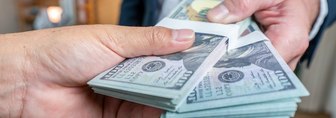Americans with full-time jobs spend an average of 37 hours per week at work. Beyond taking up approximately one-third of their waking hours, Americans’ careers shape their income, lifestyle, and friendships. A recent YouGov poll asked Americans to evaluate 30 occupations and their own occupation based on happiness, impact, and pay adequacy. The results show that the occupations Americans think have the most positive impact tend to be seen as underpaid. Politicians, CEOs, and professional athletes are seen as the most overpaid occupations but rank near the bottom when it comes to positive impact. Farmers, factory workers, and restaurant workers are thought to have the most positive impact and are seen as some of the most underpaid occupations. A handful of jobs, including doctors and computer programmers, score well on pay, happiness, and positive impact.
Overall performance of occupations
The poll asked Americans to evaluate 30 occupations in three ways:
- The impact of the work done by the people in each occupation (from very positive to very negative).
- How overpaid or underpaid are the people in each occupation (from very overpaid to very underpaid).
- The happiness of the people in each occupation (from very happy to very unhappy).
We calculated net scores for each of the three evaluations based on the percentage point difference between the percentage of Americans who place each occupation at the high end of the scale and the percentage who place each occupation at the low end of the scale: the share who said a job has a positive impact minus the share who say it has a negative impact, and the same for overpaid vs. underpaid and happy vs. unhappy.
Americans are most likely to say that professional athletes and CEOs are happy rather than unhappy (+62 and +53) and overpaid rather than underpaid (+74 and +71). However, Americans are slightly more likely to consider the two occupations' impact to be positive instead of negative (+11 and +2). Compared to pro athletes and CEOs, engineers, doctors, and airline pilots are rated similarly on happiness (+51, +46, and +45) but much higher on the positivity of their impact (+78, +76, +70).
Restaurant workers, retail sales workers, and factory workers are rated among the least happy (-22, -21, and -13) and most underpaid (-62, -53, -52) but are considered to have a very positive impact (+69, +53, and +72). Americans see farmers as the most underpaid occupation on the list (-63) and the occupation with the most positive impact (+86). Conversely, Americans think politicians are the most overpaid (+75) and have the least positive impact (-45) of the 30 occupations we asked about.
Ranking occupations by pay
Most Americans see income and benefits as important factors to consider when selecting a job. Our survey provides insight into Americans’ perceptions of pay across 30 occupations. The survey asked, “Do you think that the following groups of people are generally…?” Response options included “very overpaid”, “somewhat overpaid,” “appropriately paid,” “somewhat underpaid,” and “very underpaid.”
Occupations Americans are most likely to say are very or somewhat overpaid:
- Politicians
- Professional athletes
- CEOs
- Lawyers
- Investment bankers
Occupations Americans are most likely to say are very or somewhat underpaid:
- Farmers
- Restaurant workers
- Teachers
- Daycare workers
- Retail sales workers
While there is broad consensus on the most overpaid and underpaid occupations, Americans are divided on the pay of some other jobs. For example, 30% of Americans see professors as overpaid, while 28% see them as underpaid. Similarly, similar shares of people see scientists as overpaid and underpaid (20% and 22%). Americans are most likely to say that engineers (53%), computer programmers (51%), and plumbers (48%) are appropriately paid.
Ranking occupations by impact
Americans' opinions of occupations might also be affected by whether they think the people working in those industries have a positive or negative impact on society. Our survey also asked, “Do you think that the work the following groups of people do generally has a…?” Response options included “very positive impact,” “somewhat positive impact,” “neither positive nor negative impact,” “somewhat negative impact,” and “very negative impact.”
Occupations Americans are most likely to say have a very or somewhat positive impact:
- Farmers
- Nurses
- Construction workers
- Doctors
- Engineers
Occupations Americans are most likely to say have a very or somewhat negative impact:
- Politicians
- Journalists
- CEOs
- Lawyers
- Investment bankers
Four of the five occupations Americans are most likely to say have a negative impact are also among the five they were most likely to say are overpaid, with journalists as the one exception. However, Americans are divided on some of these occupations. While 28% think investment bankers have a negative impact, 33% think they have a positive impact.
In general, more Americans think occupations have a positive impact rather than a negative one, often by big margins. Politicians and pollsters are the only groups that a greater share of Americans think have a negative rather than positive impact. Pollsters are the occupation most likely to be seen as having neither a positive nor negative impact (39%). Politicians get by far the worst impact scores of the 30 occupations polled about.
Ranking occupations by happiness
We also asked Americans about whether the people in each of the 30 occupations are happy or unhappy. Specifically, the question asked, “When it comes to the work they do, do you think that the following groups of people generally are…?” Response options included “very happy”, “somewhat happy,” “neither happy nor unhappy,” “somewhat unhappy,” and “very unhappy.”
Occupations Americans are most likely to say are very or somewhat happy:
- Professional athletes
- CEOs
- Entrepreneurs
- Engineers
- Doctors
Occupations Americans are most likely to say are very or somewhat unhappy:
- Restaurant workers
- Customer service representatives
- Retail sales workers
- Factory workers
- Teachers
Except for entrepreneurs, the occupations Americans see as the five happiest also rank in the top five for either positive impact (engineers and doctors) or for being overpaid (professional athletes and CEOs). Three of the five occupations rated as most unhappy also ranked in the top five most underpaid occupations.
Americans are evenly split between happy, unhappy, and neither unhappy nor unhappy for many occupations. They are most divided on teachers' happiness, with 34% seeing them as unhappy and 39% seeing them as happy.
Americans’ opinions of their own occupation
We also asked Americans about these same three metrics (pay adequacy, happiness, and impact) in their own careers. Most Americans think they are either very or somewhat underpaid (58%) or appropriately paid (30%). Americans with family incomes of over $100,000 are more likely to say they are adequately paid (44%) than are those with income between $50,000 and $100,000 (28%) and those with income below $50,000 (20%). Fewer than one in 10 (7%) Americans think they are overpaid.
Americans generally think their work has a very or somewhat positive impact (75%), while another 20% think their work has neither a positive nor negative impact. Americans with a family income of less than $50,000 (67%) are less likely to say their work has a positive impact than are those with family incomes between $50,000 and $100,000 (82%) or over $100,000 (77%).
A majority of Americans (63%) say they are very or somewhat happy when it comes to the work they do, while 16% are very or somewhat unhappy. Americans with a family income of less than $50,000 (22%) are more likely to say they are unhappy with their work than are those with family incomes between $50,000 and $100,000 (14%) or over $100,000 (12%).
— Taylor Orth contributed to this article
See the results of this YouGov poll
Related:
- Which occupations do Americans think will be most affected by advances in AI?
- Which jobs do Americans think should require a college degree?
- How common do Americans think nepotism is in 10 fields of work?
Methodology: The poll was conducted among 3,000 U.S. adult citizens on three separate surveys from June 16 – 19, 2023; June 20 – 25, 2023; and June 21 – 27, 2023. Each survey was taken by 1,000 U.S. adult citizens. Each respondent was asked about a randomly selected sample of 10 of the 30 occupations. Respondents were selected from YouGov’s opt-in panel using sample matching. A random sample (stratified by gender, age, race, education, geographic region, and voter registration) was selected from the 2019 American Community Survey. The sample was weighted according to gender, age, race, education, 2020 election turnout and presidential vote, baseline party identification, and current voter registration status. Demographic weighting targets come from the 2019 American Community Survey. Baseline party identification is the respondent’s most recent answer given prior to March 15, 2022, and is weighted to the estimated distribution at that time (33% Democratic, 28% Republican). The margin of error for the overall sample is approximately 2%.
Image: Adobe Stock (DC Studio)









